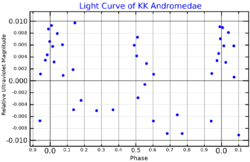Astronomy:KK Andromedae
| Observation data Equinox J2000.0]] (ICRS) | |
|---|---|
| Constellation | Andromeda |
| Right ascension | 01h 34m 16.62220s[2] |
| Declination | +37° 14′ 13.8765″[2] |
| Apparent magnitude (V) | 5.90[3] |
| Characteristics | |
| Spectral type | B9 IV[4] |
| U−B color index | −0.3 |
| B−V color index | −0.067±0.001[3] |
| Variable type | α2 CVn |
| Astrometry | |
| Radial velocity (Rv) | −1.4±1.8[5] km/s |
| Proper motion (μ) | RA: +5.719[2] mas/yr Dec.: −21.238[2] mas/yr |
| Parallax (π) | 7.4585 ± 0.1156[2] mas |
| Distance | 437 ± 7 ly (134 ± 2 pc) |
| Absolute magnitude (MV) | +0.35[6] |
| Details | |
| Mass | 3.07±0.06[7] M☉ |
| Radius | 2.7±0.4[6] R☉ |
| Luminosity | 91[6] L☉ |
| Surface gravity (log g) | 3.914±0.020[8] cgs |
| Temperature | 11,729±50[8] K |
| Rotation | 0.67 days[6] |
| Rotational velocity (v sin i) | 163±10[8] km/s |
| Age | 225[9] Myr |
| Other designations | |
| Database references | |
| SIMBAD | data |
KK Andromedae, also known as HD 9531, is a variable star in the northern constellation of Andromeda. It has an apparent visual magnitude of 5.90,[3] which places it near the lower limit of visibility to the naked eye even under good viewing conditions. An Alpha2 Canum Venaticorum variable, it varies in brightness by 0.012 magnitude every 0.66 days.[11] Based upon an annual parallax shift of 7.5 mas[2] as seen from Earth, it is located around 437 light years from the Sun. At that distance, the brightness of the star is diminished by an extinction of 0.26 magnitude due to interstellar dust.[9]
Cowley et al. (1969) assigned this star a stellar classification of B9 IV,[4] which would indicate it is a B-type star in the subgiant stage that has exhausted the hydrogen supply at its core and is expanding. It is a catalogued as an Ap star that displays an abnormal silicon abundance,[12] but has been reported to actually be a helium-weak chemically peculiar star.[13] The star has just over three times the mass of the Sun[7] and about 2.7[6] times the Sun's radius. It is an estimated 225[9] million years old and is spinning rapidly with a projected rotational velocity of 163 km/s[8] and a rotation period of 16 hours.[6] KK And is radiating 91[6] times the Sun's luminosity from its photosphere at an effective temperature of 11,729 K.[8]
References
- ↑ Hildebrandt, G (1975). "Lichtelektrische Untersuchungen der vier Ap-Sterne HD 9531, HD 10221 HD 27309 und HD 184905". Astronomische Nachrichten 295 (6): 277–280. doi:10.1002/asna.19752960605. Bibcode: 1975AN....296..277H.
- ↑ Jump up to: 2.0 2.1 2.2 2.3 2.4 2.5 Brown, A. G. A. (August 2018). "Gaia Data Release 2: Summary of the contents and survey properties". Astronomy & Astrophysics 616: A1. doi:10.1051/0004-6361/201833051. Bibcode: 2018A&A...616A...1G.
- ↑ Jump up to: 3.0 3.1 3.2 Anderson, E.; Francis, Ch. (2012). "XHIP: An extended hipparcos compilation". Astronomy Letters 38 (5): 331. doi:10.1134/S1063773712050015. Bibcode: 2012AstL...38..331A.
- ↑ Jump up to: 4.0 4.1 Cowley, A. et al. (April 1969), "A study of the bright A stars. I. A catalogue of spectral classifications", Astronomical Journal 74: 375–406, doi:10.1086/110819, Bibcode: 1969AJ.....74..375C.
- ↑ Gontcharov, G. A. (November 2006), "Pulkovo Compilation of Radial Velocities for 35495 Hipparcos stars in a common system", Astronomy Letters 32 (11): 759–771, doi:10.1134/S1063773706110065, Bibcode: 2006AstL...32..759G.
- ↑ Jump up to: 6.0 6.1 6.2 6.3 6.4 6.5 6.6 North, P. (June 1998), "Do SI stars undergo any rotational braking?", Astronomy and Astrophysics 334: 181–187, Bibcode: 1998A&A...334..181N
- ↑ Jump up to: 7.0 7.1 Zorec, J.; Royer, F. (2012), "Rotational velocities of A-type stars. IV. Evolution of rotational velocities", Astronomy & Astrophysics 537: A120, doi:10.1051/0004-6361/201117691, A120, Bibcode: 2012A&A...537A.120Z.
- ↑ Jump up to: 8.0 8.1 8.2 8.3 8.4 Huang, Wenjin et al. (2010), "A Stellar Rotation Census of B Stars: From Zams to Tams", The Astrophysical Journal 722 (1): 605–619, doi:10.1088/0004-637X/722/1/605, Bibcode: 2010ApJ...722..605H.
- ↑ Jump up to: 9.0 9.1 9.2 Gontcharov, G. A. (November 2012), "Spatial distribution and kinematics of OB stars", Astronomy Letters 38 (11): 694–706, doi:10.1134/S1063773712110035, Bibcode: 2012AstL...38..694G.
- ↑ "KK And". SIMBAD. Centre de données astronomiques de Strasbourg. http://simbad.u-strasbg.fr/simbad/sim-basic?Ident=KK+And.
- ↑ Watson, Christopher (4 January 2010). "KK Andromedae". AAVSO Website. American Association of Variable Star Observers. http://www.aavso.org/vsx/index.php?view=detail.top&oid=244.
- ↑ Renson, P.; Manfroid, J. (2009), "Catalogue of Ap, HgMn and Am stars", Astronomy and Astrophysics 498 (3): 961, doi:10.1051/0004-6361/200810788, Bibcode: 2009A&A...498..961R.
- ↑ Hric, Ladislav (July 1990), "The new helium-weak star HR 446", Astrophysics and Space Science 169 (1–2): 177–181, doi:10.1007/BF00640707, Bibcode: 1990Ap&SS.169..177H.
Coordinates: ![]() 01h 34m 16.6065s, +37° 14′ 13.727″
01h 34m 16.6065s, +37° 14′ 13.727″
 |


